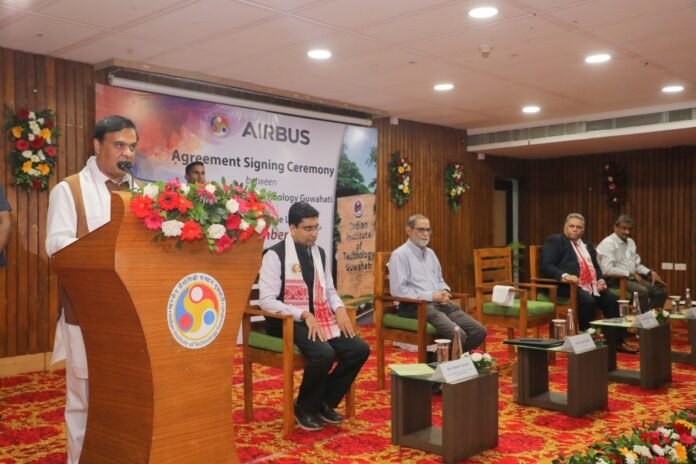Guwahati, the gateway to Northeast India, is set to undergo a major transformation in the aviation sector. Assam Chief Minister Himanta Biswa Sarma has reiterated his vision of developing Guwahati into a key regional aviation hub for South East Asia. This ambitious plan aims to enhance connectivity, boost trade, and position Assam as a vital link between India and neighboring countries.
Expansion of Lokpriya Gopinath Bordoloi International Airport (LGBIA)
One of the most major steps toward achieving this goal is the expansion of the Lokpriya Gopinath Bordoloi International Airport (LGBIA) in Guwahati. The new terminal building, which is set to be inaugurated soon, will have an impressive passenger handling capacity of 13 million annually. This expansion is expected to majorly improve air travel infrastructure, attracting more international airlines and increasing passenger traffic.
The modernized terminal will include state-of-the-art facilities, world-class amenities, and enhanced security measures to accommodate the rising number of domestic and international travelers. The project aligns with the broader vision of Act East Policy, aimed at improving regional connectivity with South East Asian nations like Thailand, Singapore, Malaysia, Myanmar, and Bhutan.
Strategic Importance of Guwahati as an Aviation Hub
Guwahati’s strategic location makes it an ideal aviation hub for South East Asia. The city serves as the primary entry point to Northeast India, which shares international borders with Bhutan, Bangladesh, Myanmar, and China. The expansion of LGBIA and improved air connectivity will facilitate trade, tourism, and cultural exchanges between India and neighboring countries.
Additionally, with new direct international flights under consideration, Guwahati is expected to witness increased business activities, investment opportunities, and tourism influx. The state government has also been in talks with various airlines to introduce more international routes, making Guwahati a focal point for global travel.
Boosting Assam’s Economy and Tourism
The enhanced aviation infrastructure will have a momentous impact on Assam’s economy. Improved air connectivity will attract investors and businesses, strengthening Assam’s position as a regional economic hub. The airport expansion will not only create employment opportunities but also stimulate growth in sectors like hospitality, trade, and logistics.
Tourism in Assam is expected to receive a major boost. With its rich cultural heritage, scenic landscapes, and renowned wildlife reserves such as Kaziranga National Park, the state is poised to attract more international visitors. Additionally, the improved air connectivity will facilitate the promotion of spiritual and adventure tourism, drawing tourists from across the world.
Gelephu Mindfulness City: A Game-Changer for Regional Collaboration
CM Himanta Biswa Sarma also emphasized the significance of the Gelephu Mindfulness City project in Bhutan. This mega infrastructural project, located near the Assam-Bhutan border, is expected to enhance cross-border economic collaboration. With better air connectivity from Guwahati, Gelephu could become a major destination for trade, investment, and tourism.
The Gelephu project is envisioned as a smart and sustainable city, focusing on wellness, business, and cultural exchanges. Improved aviation links between Guwahati and Bhutan will make it easier for business travelers, tourists, and investors to explore new opportunities in both regions.
Government Initiatives to Strengthen Aviation Infrastructure
The Assam government, in collaboration with the Ministry of Civil Aviation, has been working on several initiatives to strengthen the state’s aviation infrastructure. Some of the key developments include:
- Upgrading existing airports like Dibrugarh, Jorhat, and Silchar to handle more air traffic.
- Developing new airports in key locations to further boost regional connectivity.
- Encouraging private investment in the aviation sector to modernize facilities and improve services.
- Promoting Guwahati as a transit hub for flights connecting South East Asian countries with other parts of India.
These initiatives align with the government’s broader vision of positioning Assam as a gateway to the East, strengthening India’s connectivity with the ASEAN region.
The development of Guwahati into a regional aviation hub for South East Asia marks a new era of economic growth and connectivity for Assam. With the upcoming LGBIA expansion, improved international air links, and projects like Gelephu Mindfulness City, the region is set to witness unprecedented progress.
Under CM Himanta Biswa Sarma’s leadership, Assam is positioning itself as a major player in the global aviation sector. The state’s commitment to infrastructure development, economic expansion, and regional collaboration will make Guwahati a thriving aviation and business hub in South East Asia.



